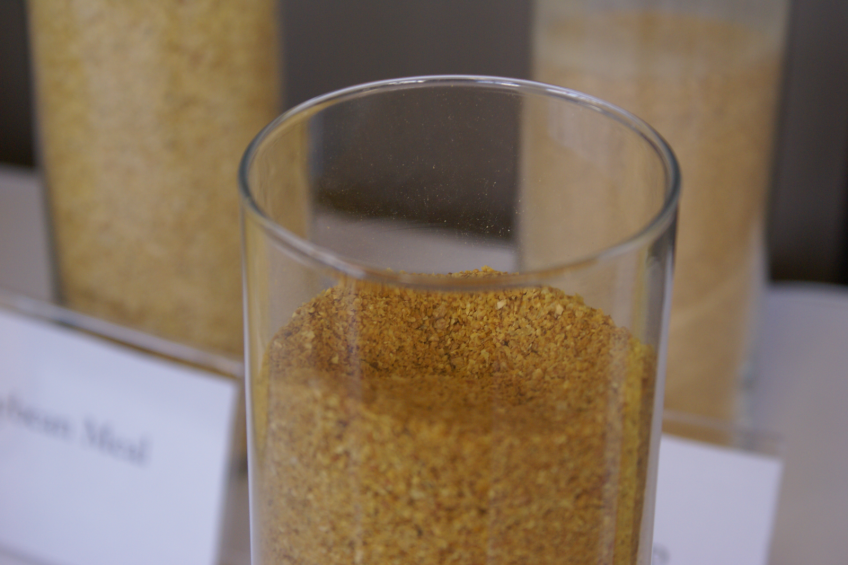How best to include DDGS in swine feed?

There are still questions about the use of Dried Distiller’s Grains with Solubles (DDGS) in animal feed, despite its use for years by pig farmers in the US. What is the appropriate inclusion level? And how is it used at various production stages? Let’s have a look.
The development of the bioethanol industry has made new grain by-products such as dried distiller’s grains with solubles (DDGS), with relatively high protein and energy levels, readily available to the livestock industry. Given that feed costs account for 60 to 70% of pig farm expenses, it is not surprising that many farmers look to substitute soybean meal, the ‘gold standard’ of protein sources, with others such as DDGS that cost half as much or less.
Nutritional perspective
Among different protein sources soybean meal is the most common one found in monogastric animals’ compound feed due to its relatively consistent nutrient content and good amino acid profile. DDGS is a protein-rich corn (maize) by-product with amino acid concentrations approximately three times greater than those in corn (Table 1). Ileal digestibility is a measure that estimates the availability of amino acids to the animal. According to US research from 2009 by Hans Stein and Gerald Shurson, attached to the University of Minnesota and the University of Urbana-Campaign respectively, standardised ileal digestibility of most amino acids in DDGS is approximately 10 percentage units less than in corn. Reduced digestibility values for dry matter and energy in DDGS can be explained with the fact that apparent total tract digestibility of dietary fibre is less than 50%.
Evaluating protein quality
Nutrients are often referred to as limiting when deficiencies result in poorer animal health and/or productive performance.
Comparing soybean meal with a crude protein level of 44% with DDGS having a 25% crude protein level, soybean meal contains much higher quantities of amino acids with better digestibility. Despite these differences, DDGS can be considered a good source of sulphur-containing amino acids.
It is always recommended to check lysine to crude protein (CP) ratio of DDGS since these can give an indication about possible heat damage during the drying process. A lysine/CP ratio of 2.8% or higher for average quality DDGS is common in terms of lysine digestibility.
Improving nutrient digestibility
While plant-based phytogenic feed additives, or botanicals, cannot change the quality of protein, they can exert a positive influence on nutrient digestibility. This is particularly important for piglets given that they have underdeveloped digestive tracts. A 41-day trial involving 25-day old piglets demonstrated that the use of Digestarom, a phytogenic feed additive by Biomin, improved the digestibility of crude protein by 9.8%, crude fat by 7.7% and starch by 1.4% versus the control group ( Figure 1). Overall the average ileal digestibility of amino acids in piglets improved by more than 10% with phytogenic feed additive supplementation.

Growers and finishers
DDGS can be used up to 20% in growing-finishing feed without having a significant negative effect on performance parameters. However, in many cases increased DDGS dosage in finished feed resulted in reduced weight gain and increased feed conversion ratio. Removal of DDGS from the diet three to four weeks prior to slaughter can reduce the negative impact of DDGS on carcass fat. In eight out of 18 experiments in which growing-finishing diets with DDGS inclusion up to 30%, the carcass dressing percentage was reduced. One can expect a 0.03% carcass yield reduction per 1% DDGS in the diet, but withdrawal of DDGS six weeks prior to harvest can prevent reductions in yield.
Nursery pigs and piglets
Nursery pigs from two to three weeks post-weaning may be fed diets containing up to 30% DDGS without a significant negative impact on growth performance. Piglets are highly sensitive to mycotoxins produced by Fusarium fungi, which can thus limit the use of DDGS in piglet feed since mycotoxin contamination of corn and its by-products is quite common. Corn samples analysed as part of the 2014 Biomin Mycotoxin Survey tested positive for deoxynivalenol in 73% of cases, T-2 (13%), fumonisins (72%), zearalenone (55%), aflatoxins (23%) and ochratoxin A (5%).
The most mycotoxin contaminated fractions of corn are the outer portions which remain in DDGS after the fermentation process. Because mycotoxins do not dissolve or evaporate, mycotoxin concentrations in resulting DDGS are typically three times higher than in the initial corn. Again, 2014’s mycotoxin survey results indicate that among common swine feed ingredients DDGS registered the highest prevalence of aflatoxins, zearalenone, deoxynivalenol and fumonisins, occurring in 39%, 72%, 81% and 81% of samples tested. T-2 toxin and ochratoxin A registered 26% and 27%, respectively.
In a recent 40-day trial 300 piglets were assigned to control and treatment groups, both of which were exposed to low, naturally contaminated feed. The treatment group received a preventive dosage of mycotoxin detoxification additive, Mycofix Plus. Results show that detoxification significantly improved daily weight gain.

Sows
Few studies address DDGS inclusion in sows’ diets. In 2012, a group of researchers around Lee Johnston and others at the University of Minnesota, USA, conducted a trial from first to third parity with 400 sows in control and trial groups. The sows in the control group were fed a corn-soybean diet. The trial group diet was supplemented with 40% DDGS during gestation and 20% during lactation. In case of piglets born, piglets weaned per litter and piglet mortality, no significant differences were observed, though key performance parameters for the DDGS group were on average 4% lower compared to the control group.
References available on request.











